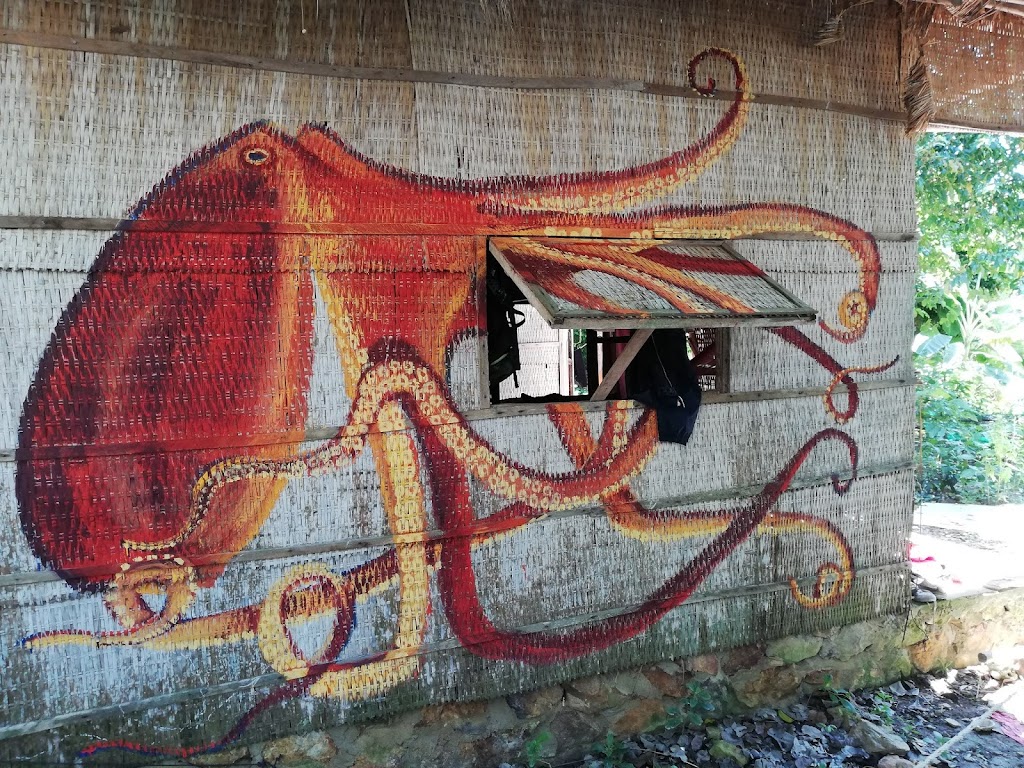“The world will not be destroyed by those who do evil,
but by those who watch them without doing anything.”
Albert Einstein
Make art, Not Waste was born under the guidance, support and encouragement of Marine Conservation Cambodia (MCC), notably MCC’s founder Paul Ferber.
MCC is a non-profit marine conservation organisation based in Koh Ach Seh, Kep archipelago. Located on a remote island, MCC is constituted of driven and dedicated individuals working hard to protect the ocean.
Threats to marine life come in the shape of illegal and destructive fishing vessels, as well as pollution and habitat loss.
What used to be one of the biggest seagrass meadows and beautiful, bio-diverse coral reefs in the world is fast being decimated by illegal bottom trawling. Trawlers rely on dragging weighted nets along the seafloor, leaving a desert of destruction in their wake.
MCC team with local Fisheries apprehend illegal trawling boat, 2016
Not only do trawling vessels uproot precious seagrass and break coral structures, they also catch non-target species such as turtles, dolphins and juvenile fish.
The MCC patrol team took it upon themselves to put an end to this unsustainable and deadly practice.
MCC’s patrol/supply boat with founder, Paul Ferber at the bow in 2016
MCC has developed a hard-working team of staff and volunteers, working closely with local communities and government to ensure that parts of the Cambodian sea are protected for future generations.
One of their main activities is the underwater concrete structure project. The goal is to create hundreds of concrete blocks, about 1.3m long each, deploy them in strategic places and assemble them like giant lego blocks into underwater structures.
|
The anti-trawling devices. Image of block structure from here |
1. Stop illegal trawling within the marine protected area.
Trawling nets get stuck on them, physically stopping the boats. The structures are strategically placed to delimit the no-take fishing zone. Their presence is deterrent to the illegal vessels that would otherwise “sneak in”, often from bordering Vietnam, to steal from Cambodian protected waters.
2. Create habitats and rebuild the damaged marine ecosystem.
Many species rely on seagrass beds and coral reefs as their home. They are rich ecosystems providing shelter and nursing grounds for juveniles at a critical stage of development and growth.
This project is a real success story as within months life has started to live in, on and around the structures, they are veritable hotspots of marine life.
|
Paul Ferber with Eng Cheasan, a local government official, dropping one of the first blocks in 2018 |
Check out some videos of the structures underwater on MCC’s Youtube channel
|
Mao & Rachana load blocks onto the boat from the pier, 2018 |
Other key MCC activities are Seahorse Research, Seagrass Research, Marine Fisheries Management Area zoning, Outreach with local community members, and the Cambodian Marine Mammal Conservation Project.
|
Hippocampus spp. on MCC’s house reef, they are often found holding on to pencil urchins. This is not ideal as urchins have been known to eat seahorses. Unfortunately the seagrass they would usually hold on to is fast disappearing because of trawling and wildlife trade. |
|
Endangered Irrawady dolphins in the Kep MFMA, photo from Sarah Tubbs |
|
These Fish Aggregation Devices built out of bamboo by MCC volunteers float on the surface of the water, anchored to a concrete block and create amazing surface habitats for many marine species. |
|
Nina, Rachana, Tanguy and Tom deploy Fish Aggregation Devices, 2018 |
MCC is dedicated to sharing knowledge with Cambodian people, youths especially, thus enabling them to become the marine conservationists of tomorrow.
Many local schools, universities and interest groups are invited to the island to learn about the marine ecosystem, and even witness marine life first-hand through snorkeling and dive training.
My journey from MCC to Make Art, not Waste
I was doing an academic internship at MCC in 2016, studying the bleaching of certain corals on the house reef, when I took part in my first beach clean on Koh Seh. This changed the course of my life forever.
|
Bleached soft coral, Koh Seh house reef 2016
There were so many different shapes, sizes and colours of plastics. More washing ashore daily. Who was using these items? Where did they come from? Why were they ending up on this tiny island in the middle of the ocean?
|
|
One of my first beach cleans on Koh Seh in 2016 |
I returned to University in the UK after 3 months at MCC, and I was determined to learn more.
I did my environmental science research dissertation on how to use art as a tool for creating behavioural change in the public regarding plastic waste.
After graduating, I came back to MCC where I became resident artist and “Beach Clean Master”, leading the Ocean Plastics project.
|
Nina at MCC in 2017 All the rubbish from beach cleans has to, unfortunately, be burnt in an incinerator on the island. This is the reality of island life. It’s not our trash but we do have to dispose of it somehow.
|
It was devastating to be finding so much non-degradable trash on the beach and in the ocean eveyday, especially now that I knew just how deadly the effects were.
I started to collect, sort, clean and store the plastic to be able to make art projects from the trash.
|
With Sarah Tubbs, leader of the Cambodian Marine Mammal Conservation project, sorting and cleaning beach plastic in 2017
Making things from the trash was the best way I could think of at the time to stop so much of it from being incinerated.
|
As we were cleaning the beach, we would bring different bags for different categories: bottles, styrofoam, hard colourful plastics for art projects, etc.
In 2017 I started the Make Art, Not Waste art-based communication project at MCC. This was my way of getting the massage out to the wider world: oceans plastics are a massive problem and we all need to be part of the solution.
|
The first “lighter lampshade” I ever made, at MCC in 2016 |
|
Teaching Liger students from Phnom Penh about Plastic Pollution in a marine environment, MCC 2017. |
|
Teaching MCC volunteers about Plastic Pollution in 2017.
MCC is all about allowing people to be creative, thoughtful, proactive and inventive in their approach to marine conservation.
|
|
Trip to the mainland, on the boat with Paul, 2018 |
They were very supportive of all my artistic endeavours on the island. They even allowed me to paint colourful sea creatures on all the bungalows!
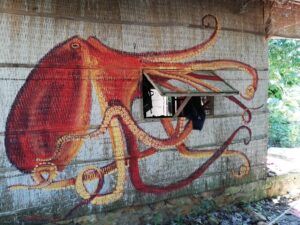 |
| Octopus painted on the side of a bungalow, 2018 |
|
Putting up signs with boat captain Nang “Protect the Ocean” |
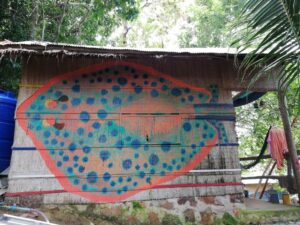 |
|
Stingray painted on side of bungalow, 2018 |
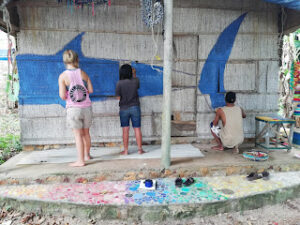 |
|
Barracuda painting going up with the help of Amy, Rachana & Nang, 2018 |
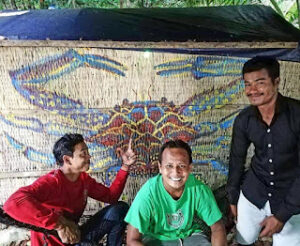 |
|
Kep’s famous Blue Swimmer Crab painted on Mean’s room, with Nang Mean & Tin, 2018
With the help of MCC-secured funding, we were able to provide plastic pollution presentations, organise cleanups and create artworks with 6 different schools on the Kep mainland. We reached over 300 students ages 3-18 with our outreach project.
|
|
Teaching at Sala Monkey School in Kep as part of outreach project, 2018 |
| Nina underwater |
|
Thanks to the staff, volunteers and all the people who have helped spread the message about the dangers of plastic pollution and became a part of this movement by encouraging people around them to adopt sustainable habits, participating in cleanups, eating less fish, and caring more about this planet that sustains us.
|
Be sure to check out their website, follow them on social media and stay updated on their wonderful work.
Everyone can make a difference and help protect wildlife by supporting organisations such as MCC.
